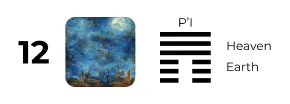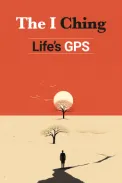What is Hexagram 12?
'Standstill (Stagnation)' in the I Ching signals stagnation, emphasising patience and preparation over haste. It represents a transitional time with halted progress but continued internal growth. This phase calls for humility, receptivity, and waiting for the right moment. It highlights personal growth, value maintenance, and aligning with higher wisdom during challenges.

I Ching Hexagram 12 - Standstill (Stagnation)
When faced with a stagnant period, focus on your mindset.
Summary
Embodies a state of stagnation, inactivity, and immobility. It advises against taking immediate action, instead recommending patience and preparation for the right moment to act.
Interpretation
Represents a time of uncertainty and transition, where progress may seem hindered. Despite external obstacles, inner growth and transformation can continue. This period calls for humility, patience, and receptivity, encouraging one to wait for the opportune moment rather than forcing action.
Line 1
Advises stepping back and letting go of attempts to control the situation. It encourages cultivating inner peace, focusing on personal growth and transformation, and waiting for the right guidance for eventual success.
Line 2
Encourages steadfastness in values and principles during challenging times. Enduring with patience, humility, and grace helps overcome obstacles and inspire others. It advises against succumbing to negativity and maintaining a positive outlook.
Line 3
Suggests allowing those who have strayed to realise their mistakes. It advises against imposing your will or expectations, advocating for maintaining integrity and independence, and upholding one's beliefs and values.
Line 4
Emphasises aligning with higher power and wisdom, maintaining a balance between humility and assertiveness. Staying alert and focused on personal growth allows positive changes to manifest in the surrounding world.
Line 5
Advises holding steadfast to beliefs, values, and inner wisdom to secure progress and maintain stability. Commitment to truth and goodness helps overcome fear and uncertainty, ensuring a successful outcome.
Line 6
Promises the end of stagnation through consistent efforts of a person of exemplary character. Maintaining a pure and correct inner attitude, the power of inner truth influences others positively, bringing about good fortune.
Note: This is a summarised version. For the complete version, get the app.
Unveiling the Wisdom of Hexagram 12: A Guide to Personal Transformation
Dive into the ancient teachings of I Ching Hexagram 12, known as Stagnation or Pi, as we uncover its profound wisdom for self-improvement, personal growth, enlightenment, and awakening. This exploration is not just an academic exercise; it's a practical journey into integrating timeless truths into our contemporary lives, fostering deep personal transformation and a richer understanding of our personal journeys.
Core Insights
Essence of Hexagram 12
Hexagram 12, Stagnation, represents a period of standstill or decline, where the forces of yin and yang are out of balance, leading to a lack of progress and potential discord. It symbolises the challenges that arise when communication breaks down and negative influences prevail.
Historical Wisdom
Traditionally, this hexagram has been seen as a warning against complacency and corruption, urging a return to ethical principles and the re-establishment of harmony and balance in order to overcome periods of stagnation.
Personal Growth and Self-Improvement
Reflective Questions
- What areas of my life are currently experiencing stagnation, and what might be causing this standstill?
- How can I re-establish balance and positive flow in these areas?
- What ethical principles or values do I need to return to in order to navigate through this period of stagnation?
Actionable Insights
- Identify any negative influences or habits that may be contributing to stagnation and make a conscious effort to address them.
- Seek out positive influences and environments that promote growth, balance, and forward movement.
- Embrace practices that enhance communication and understanding, both within yourself and in your relationships with others.
Path to Enlightenment
Mindfulness Practices
Incorporate mindfulness and meditation practices that focus on clearing blockages and restoring balance, such as focused breathing exercises or guided visualisations aimed at rejuvenating stagnant energy.
Philosophical Reflections
Contemplate the cyclical nature of life and the inevitability of periods of stagnation as opportunities for reflection, realignment, and renewed growth.
Awakening to Life’s Mysteries
Transformational Stories
Share stories or anecdotes that illustrate the transformative journey from stagnation to renewal, highlighting the lessons learned and the strategies employed to overcome challenges and resume progress.
By exploring the wisdom of Hexagram 12, we learn to recognise and address the causes of stagnation in our lives, finding within these challenges the seeds of renewal and the potential for significant personal transformation and enlightenment.
More Information about the I Ching
Understanding the Structure of Hexagrams
Every hexagram in the I Ching, from the first hexagram to the 64th, is constructed using a combination of trigrams. These trigrams, the building blocks of every I Ching hexagram, represent different natural elements and concepts, such as wind, water, fire, and mountain. The upper trigram and lower trigram interact, giving birth to the unique energy of the hexagram. By delving into the trigrams that compose a hexagram, one can unearth its deeper meanings and implications.
The Timeless Nature of I Ching
The I Ching, often referred to as the Book of Changes or Yijing, has remained relevant due to its universal themes. While society has evolved, the essential human emotions and challenges we face remain. The 64 hexagrams of the I Ching address these timeless concerns, making it an untiring guide for introspection and growth. Whether you're contemplating the creative power of Hexagram 1 or the dynamic interplay in other hexagrams, the wisdom remains ceaseless.
The Philosophical Foundations of I Ching
The I Ching is deeply rooted in Taoist and Confucian philosophies. It's a reflection of the world's natural order, emphasising the dynamics of yin and yang. Studying the hexagrams provides insights into the ancient Chinese understanding of balance, change, and harmony in the universe.
How to Consult the I Ching
Traditionally, seekers would consult the I Ching using yarrow stalks or coins. The divinatory process, often seen as an interaction with the oracle, results in a specific hexagram. This hexagram, whether it be the light-giving Hexagram 1 or another, provides guidance tailored to the individual's query. Modern enthusiasts might also opt for a free I Ching reading online to understand their current situation better.
Incorporating I Ching Hexagram 12 into Daily Life
Hexagram 12, representing stagnation and the challenges it poses, offers profound insights into the trials of life. The six lines of this hexagram teach us about enduring periods of standstill with grace and patience. In our ever-evolving world, Hexagram 12 serves as a reminder that growth often happens beneath the surface during seemingly stagnant times. By reflecting upon its teachings, we learn the value of patience, perseverance, and hope, understanding that every phase, even one of pause, has its purpose.
Incorporating I Ching into Self-Improvement and Personal Growth
The I Ching, with its intricate tapestry of hexagrams, serves as a profound compass for those on a journey of self-improvement and personal growth. Each hexagram offers insights into life's challenges and opportunities, guiding individuals to introspect, evolve, and align with the universe's natural rhythms.
Regularly consulting the I Ching offers a bridge to ancient wisdom, helping seekers tap into their inner strengths and potentials. The detailed interpretations of each hexagram, from the dynamics of its yang and yin lines to its overarching message, act as roadmaps for personal development. They shed light on one's strengths, highlight areas for growth, and provide direction in times of uncertainty.
For those dedicated to personal evolution, the I Ching is an invaluable guide. It aids in discerning the optimal paths in life, understanding relationship dynamics, and fostering a harmonious balance in all endeavours. Through its teachings, individuals are equipped to cultivate essential virtues like patience, resilience, and empathy. This not only empowers personal growth but also enables one to be a positive force in the broader world.
In today's rapidly changing world, the I Ching remains a pillar of timeless wisdom. It beckons individuals to journey inward, embrace continuous learning, and cherish the ever-evolving process of self-betterment.
Consult I Ching
Choose a Hexagram Number
How to use the coin method to consult the I Ching
Consult the I Ching online. Use our coin method simulation and build your own hexagram.
Useful Links
- Revolutionary I Ching App to harness Insights for Personal Growth, Download AI Ching App
- What is the I Ching
- How to consult the I Ching
- Consult the I Ching Online
- Discover the ‘Daily I Ching’ for universal guidance.
- Access all the I Ching Hexagrams 1 to 64
- Buy the book, Embracing Life’s Journey Your Guide to Personal Growth with the I Ching
- Little Panda Learns the Tao: Stories of Nature’s Balance. Download on Amazon
- Discover Inner Peace, one day at a time
FREE Ebook - The I Ching: Life’s GPS

The Ultimate Guide to Life's Answers
Unlock ancient wisdom. Discover how the I Ching can guide your decisions and bring clarity to your path—your answers await.






